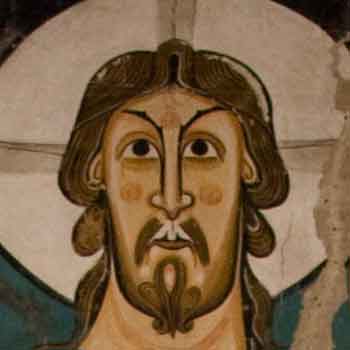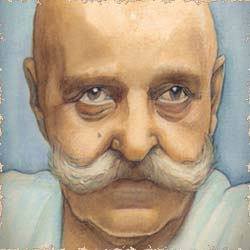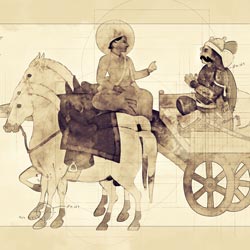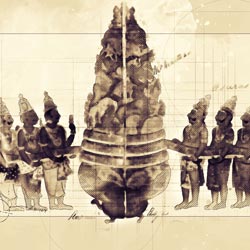
The precepts of Christianity are naturally associated with the sayings of Jesus. These sayings are scattered through the Gospels, either as isolated teachings, or as parts of longer sermons preached by Jesus to his followers. In most cases, Jesus speaks directly, addressing mainstream topics his audience would have been familiar with, but giving them a new light. For example, in the Sermon on the Mount, Jesus says, “You have heard that it was said to those of old, ‘You shall not murder; and whoever murders will be liable to judgment.’ But I say to you that everyone who is angry with his brother will be liable to judgment;” also: “You have heard that it was said, ‘You shall not commit adultery.’ But I say to you that everyone who looks at a woman with lustful intent has already committed adultery with her in his heart.” In these cases, Jesus addresses Jewish laws well-known to his audience, and revises the laws or raises their standard. By this token, Christianity is an invitation to all. Becoming a Christian is a matter of acknowledging these precepts and living by them.
Alongside this inclusive invitation, there runs a contradictory thread of exclusivity: an Esoteric Christianity. Much of Jesus’ teaching is given in the form of parables: the Parable of the Lamp, the Parable of the Speck and the Log, the Parable of the New Cloth on the Old Garment, and some fifty other allegories that convey both a direct and a more hidden meaning. In one episode of the Gospels, when Jesus attracts a particularly large gathering, with people all crowding around to listen to him, he steps onto a boat with his disciples and preaches the Parable of the Sower. This is a story of a farmer sowing seeds in his field. For various reasons, which Jesus describes, most of the seeds never take root and only a few end up bearing fruit. At the end of the sermon, the disciples question Jesus: “Why do you speak to the people in parables?” He replies: “Because the knowledge of the secrets of the kingdom of heaven has been given to you, but not to them.” Jesus then decodes the Parable of the Sower for his most intimate circle of followers. The seeds are his message. The various reasons they fail to take root represent the various ways his message is wrongly received by most of the people who come to listen to him. The few seeds that do bear fruit represent those few souls who hear Jesus’ message and understand it.
If they hadn’t suspected it already, in this meaningful moment Jesus’ disciples realize that their teacher’s message carries a double meaning: an Exoteric Christianity meant for the majority of listeners, and an Esoteric Christianity meant for those few able to understand.

The Tower of Babel | Circle of the Confusion of Tongues
Definition of Esoteric
Esotericism is defined as:
- understood by or meant for only the select few who have special knowledge or interest.
- belonging to the select few.
- private; secret; confidential.
- (of a philosophical or similar doctrine) intended to be revealed only to the initiates of a group.
The idea of esotericism long predates the New Testament. In the Old Testament, in the Book of Genesis, we are told of a united human race, speaking a single language, that decides to build a tower with its top reaching into the sky. God, observing the hubris behind this endeavor, confounds their speech so that they can no longer understand each other, and scatters them around the world. George Gurdjieff references this Old Testament story in speaking of an outer and inner circle of humanity: “[The outer] circle is sometimes called the circle of the ‘confusion of tongues’, the circle in which each one speaks in his own particular language, where no one understands another and takes no trouble to be understood.” i
It is the inability or ability to understand that distinguishes the different circles of humanity. Just as in the Parable of the Sower, it is the ability of Jesus’ close disciples to understand his message, which then takes root in their hearts. Understanding is what distinguishes between Exoteric and Esoteric Christianity.

The Tower of Babel | Circle of the Confusion of Tongues



Esoteric Christianity and the Story of the Life of Jesus
While more than fifty of Jesus’s parables appear in the Gospels, might the story of the Gospel itself be a parable writ large? If we approach its miracles as historic truths, then we are left to either doubt or believe in them. But if we view Mary’s conception by God, the Adoration of the Magi, the Massacre of the Innocents, and many more such episodes, as allegorical, then we access a deeper level of interpretation; an Esoteric Christianity hidden behind the exoteric meaning.
In retelling the story of the life of its founder allegorically, Esoteric Christianity falls in line with other religions. The life of Moses, who freed the Israelites from slavery and led them to a Promised Land, also lends itself to symbolic interpretation. The life of Muhammad, who united the warring tribes of Mecca and established Islam, was retold in remarkable detail by later Islamic authors, its many nuances laden with symbolism. And the life of Prince Siddhartha, who grew to see through the allure of worldly riches and attained enlightenment, laid the foundation for a structured teaching of Esoteric Buddhism. Exoterically, the biographical stories acquaint followers with the lives of their founders. Esoterically, an archetypal path is laid out that maps the steps from inner slavery to conscious freedom.
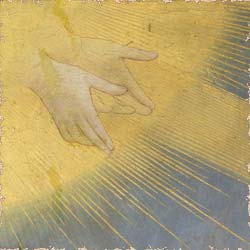
God | Fra Angelico
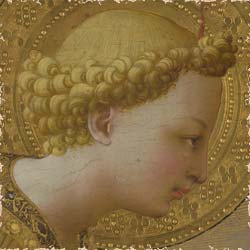
Gabriel | Fra Angelico
The Esoteric Meaning of the Divine Conception
If, indeed, the life of Jesus is such a map, then the first step should be his conception. The angel Gabriel appears to the Virgin Mary to announce that God has chosen her to bear his son. This is a miraculous conception in which the progenitor is divine, so that Mary’s virginity is maintained. The Annunciation is a common theme in Christian art, and while the representations vary, the central figures remain the same: God, sometimes visible, sometimes implied; Gabriel, appearing as if having swiftly descended from heaven with a message; Mary, usually portrayed in prayer. And the Holy Ghost, often symbolized by a white dove fluttering towards the virgin.
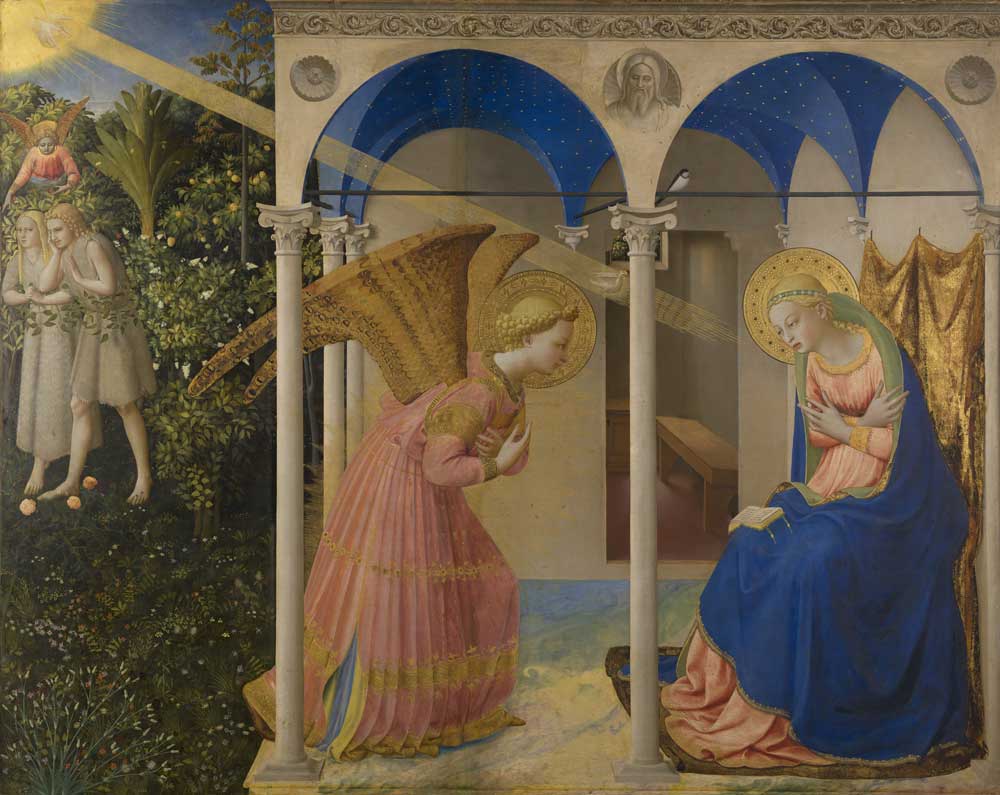
The Annunciation | Fra Angelico
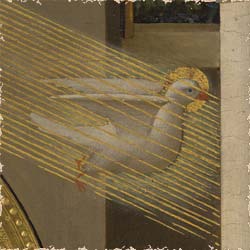
The Holy Ghost| Fra Angelico
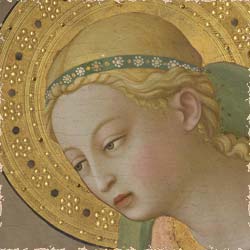
Mary | Fra Angelico
Esoteric Christianity portrays this step as very fragile: “The true life of grace in man is, in its beginning, only a seed, a spark. It is still only a feeble candle glimmering in the densest fog,” says Theophan the Recluse ii. The Holy Ghost embodies a spark. Like a flash of inspiration, it descends on Mary from a higher world, full of potential. But a spark is short lived. If Mary hesitates, it will disappear. Can she provide the fuel necessary for its combustion?
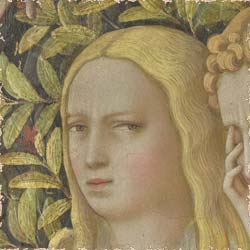
Eve | Fra Angelico
In one representation of this scene, Fra Angelico contrasts the Annunciation with the Expulsion from Eden. The pairing is self-explanatory: Adam and Eve sever a connection with God; the Virgin Mary re-establishes it. The same female model is used to represent both Eve and Mary. Esoterically speaking, these are not two different women, separated by 4000 years of history; they are two contrasting states of emotional receptivity. In one, we are governed by our own willfulness and disregard the spark of a higher impulse. In the other, we are receptive to the spark, and can nourish and augment it.
Contrary to the heavy consequences Exoteric Christianity typically associated with the ‘Original Sin,’ Esoteric Christianity presents the loss of Eden as easily recoverable. Eve must only turn and backtrack a few yards of grass towards the chapel, to become the receptive Mary. Our connection with the higher can be lost and regained in an instant. Or in the words of Theophan the Recluse, “When inner peace is lost, such a state is not permanent. If the sufferer remembers himself, he returns to himself and repents and re-establishes his habitual inner order.” ii

Eve | Fra Angelico

Mary | Fra Angelico

Mary | Fra Angelico



Esoteric Christianity Personifying Natural Laws
Esoteric Christianity has often been misunderstood. Its way of teaching through analogy has often been interpreted as a deliberate intention to deceive by hiding the truth. In fact, according to the esoteric approach, this is done by natural constraint rather than choice, because the truth cannot be expressed literally. “Pure knowledge cannot be transmitted,” said George Gurdjieff, “but by being expressed in symbols it is covered by them as by a veil, although at the same time for those who desire and who know how to look this veil becomes transparent.”i.
The Similarity Between Cosmoses
Truth can be expressed symbolically because of the principle of cosmoses. The universe is a tree, its creator a trunk from whom the creation branches out exponentially. Each new tier of branches mirrors the tiers before it, although on a smaller scale. Each is a cosmos governed by the same laws. As above so below and as within so without. One need only comprehend these laws in any given cosmos to perceive their action in everything.
The human being is also a cosmos in miniature, a micro-cosmos. From our vantage point as humans, some laws are easier to observe in ourselves, while others are easier to witness in the larger cosmoses. The next cosmos above us in scale is the world of nature. According to the theory of cosmoses, nature is governed by the same laws that govern us, only on a different scale. Therefore, anything we observe in nature has an equivalent in ourselves. All of nature perpetually cycles through birth, maturation, fruition, and destruction. This is such a fundamental aspect of nature that it could be said seasonality is one of nature’s main laws. If so, then Esoteric Christianity must also model its teaching around this fundamental law.

Visitation | Middelrijns Altar
John the Baptist
Which brings us back to the Gospels. Mary is not the only woman in the Gospels to experience a miraculous conception. Six months before Mary conceives—apparently to the day—Elisabeth, the wife of Zechariah and a relative of Mary, miraculously conceives in old age. Although she and her husband had led righteous and blameless lives, they had been denied the gift of children. Elisabeth is surprised to find herself pregnant and secludes herself for five months until, on the sixth month, she is visited by Mary, who is newly pregnant with Jesus. When the two meet and embrace, the embryos leap in their wombs. Two miracles embrace: Mary has conceived before normal child-bearing age, while still a virgin; Elisabeth has conceived past the normal child-bearing age, in her old age. This scene is frequently depicted in Medieval Christian art and is known as The Visitation.
The conception and birth of Jesus and John coincide with the four major divisions of the year: Jesus is born on December 25th, right around the winter solstice. This means he was conceived around March 25th, on the Spring equinox. John, who is six months older than Jesus, is born on the Summer Solstice and conceived on the Autumn Equinox. He even hints at this cyclical relationship between him and Jesus, the Savior he is destined to make way for: “I am not the Christ,” says John to his followers, “but I have been sent before Him; He must increase, but I must decrease.” iii
John is the last Old Testament prophet. Jesus is the first prophet of the New Testament. Together, they personify opposite phases in a never-ending cycle. Everything new must grow old and everything old must renew. How the micro-cosmos human being can embody this mystical regeneration is the ultimate lesson of Esoteric Christianity.
[RODNEY COLLIN] In the circle of the year tradition marks three major points—the festival of the midwinter solstice or Christmas, when all life is hidden and invisible; the festival of rebirth or Easter; and the festival of harvest. These three festivals are typified by the three stages of natural growth—root, flower and fruit—and in a very general way their intermediate periods represent, not only for plants, but for all living beings an ever-repeating cycle of gestation, ripening and reaping. iv

Visitation | Middelrijns Altar
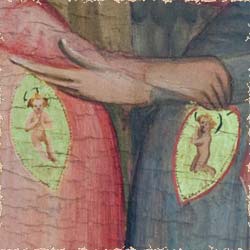
Visitation | Detail of Embryos | Middelrijns Altar

Visitation | Detail of Embryos | Middelrijns Altar



The Esoteric Interpretation of the Nativity
The next milestone in Esoteric Christianity is the Nativity. Jesus is born (in the northern hemisphere) on the winter solstice, the darkest time of year. Astronomically speaking, his appearance coincides with the end of a six-month decline in light. From this milestone onwards, daylight will gradually increase. Hence, the Nativity bears with it both good and bad tidings: while winter is still before us in all its might, we perceive light at the end of the tunnel and a glimmer of hope.
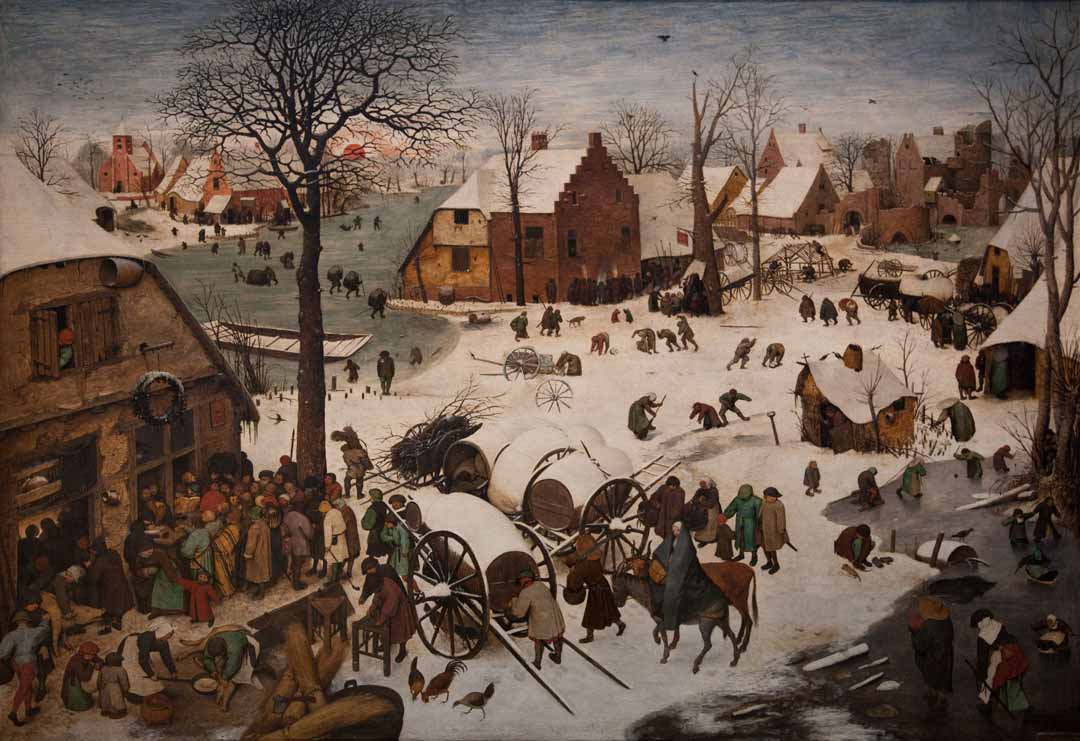
Hope is born in the dark, from the knowledge that, although things are presently difficult, we are at least headed in the right direction. Artists who followed in the wake of the Esoteric Christian tradition—and who were in touch with its esoteric interpretation—incorporated this understanding in their interpretations of the Nativity. Peter Brueghel the Elder, for example, placed the Holy Family in a wintry Flemish landscape. The scene emphasizes the frigidity of winter; everything has come to a standstill. Under these dire conditions, nothing can change. At this stage, the imminent birth of Jesus is so unsuspected and the Holy Family is so inconspicuous, that we might easily mistake Brueghel’s painting for a typical wintry village-scape. Only closer examination will reveal the painting’s nuances and the miracle that is about to occur.
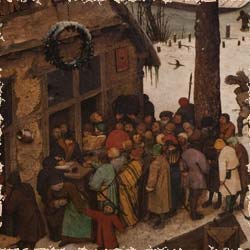
People Crowding at an Inn

Sunset
On the left-hand side, people crowd together to book rooms in an inn. In the distant background, the setting sun forewarns us of the day’s end. Time is limited and one certainly wouldn’t want to remain outdoors on such a snowy, wintry night. A few feet away from the crowds, at the center of the canvas, a man with his back to us leads an ox and an ass. The man is a carpenter as is evident from the saw he’s carrying. A woman is seated on the ass. Since the ox and ass are well-known symbols of the Nativity, the woman can only be the Virgin Mary. She seems advanced in pregnancy; a well-placed fold in her blanket reveals this. Joseph hopes to rent a room for her impending delivery, but in vain: “And she brought forth her firstborn son… and laid him in a manger; because there was no room for them in the inn.” v
These lowly conditions at Jesus’ birth are, in fact, ideal. Is it not in our darkest moments that a spark of good advice is best received? Who needs more light when spring is in full swing? When the setting sun in Brueghel’s painting rises again to usher in a new day, nothing external will have changed in the frozen Flemish village. But a savior will have been born. Brueghel is likening the birth of Christ in a freezing snowy winter to the birth of hope in the darkest hour. The tide has begun to turn; from now on, each day will be ever so slightly brighter, till spring will altogether thaw us back to life.
[To be continued]

People Crowding at an Inn

Sunset
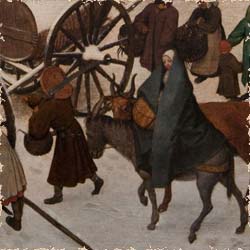
The Holy Family

The Holy Family



The Esoteric Interpretation of the Epiphany
Our overview of Esoteric Christianity so far has covered the Annunciation (where it is announced to Mary that she has been chosen to bear the Son of God), the Visitation (where she is visited by Elisabeth, mother of John the Baptist), and the Nativity (where she gives birth to Jesus in a stable). The next chapter in this symbolic unfolding is the Epiphany, so called because ‘Epiphany’ means ‘manifestation.’ It is not until 12 days after the birth of Jesus that his birth becomes manifest to the world.
To understand the esoteric meaning of this episode, we must first understand the Esoteric Christian approach to the concept ‘world’. Here we can defer to an early Christian collection of texts by different authors, known as the Philokalia, which was used in the Eastern Church for the instruction of monks:
[PHILOKALIA] When you hear that it is necessary to withdraw from the world, you must first understand the term ‘world,’ not in its everyday meaning, but in its purely inward significance. ‘World’ is a collective name, embracing what are called passions. When we want to speak of passions collectively, we call them ‘the world’; when we want to distinguish between them according to their different names, we call them passions. vi
We must also keep in mind that symbolism is based on the similarity between worlds, or cosmoses. As above so below and as within so without. Because the external world we inhabit mirrors our internal world, stories about the external world can effectively serve as psychological lessons. Just as the external world is divided into continents that are subdivided into countries, so is our inner world divided into functions and subdivisions of functions. The Philokalia calls these functions ‘passions’ because they are the driving force behind all our actions.
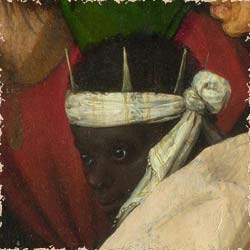
African King
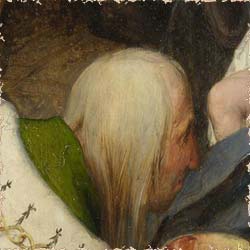
European King
The Gospel, however, outwardly adheres to the story of Jesus as if narrating historical events. The birth of Jesus, unknown at first, is made manifest through a star that appears in the east and leads the Magi to Israel: “When Jesus was born in Bethlehem of Judaea in the days of Herod the king, behold, there came wise men from the east to Jerusalem, saying, Where is he that is born King of the Jews? For we have seen his star in the east, and are come to worship him.” vi
Artistic depictions of this scene portray the Magi as three kings of different racial origins. That they are three is implied by their having brought three gifts: gold, frankincense, and myrrh. That they are kings is implied by those gifts having been too costly for ordinary people to afford. And that they are of different racial origins is rooted in the ancient view of the world itself. The ‘known’ world of ancient times was comprised of Europe, Asia, and Africa. Each Magi was thought to have been the reigning king of one of these three continents.
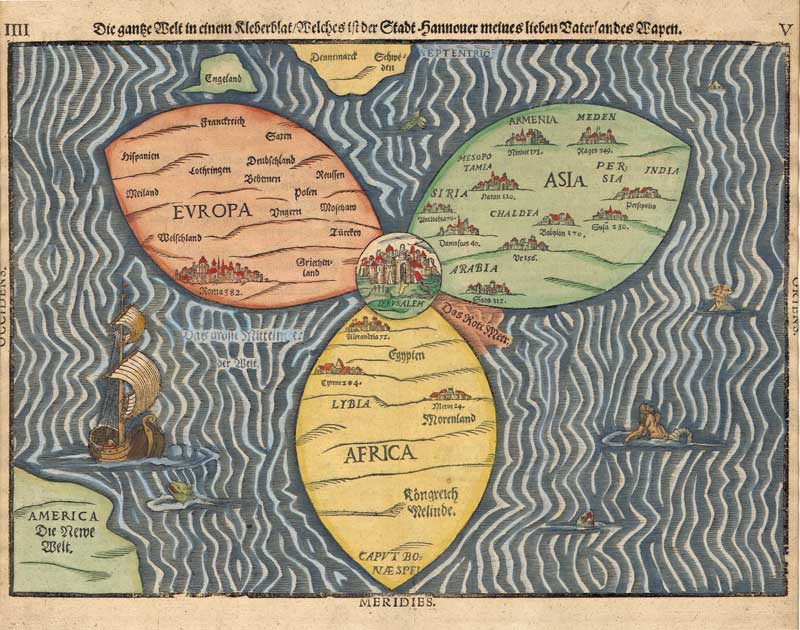
The three continents with Jerusalem in the center of the World, 1581
It goes without saying that it would have been extremely unusual for kings to convene like this, let alone to kneel in homage to anyone in the way they are traditionally depicted as bowing before the child Jesus. The Epiphany, then, stands on very shaky historical ground and begs for alternate interpretations. Rather than a historical king who will come to rule the entire known world, the story of Jesus outlines the archetypal path individuals must travel in order to free themselves from their passions and establish self-government.
[GURDJIEFF] “The general psyche of… man is split into three… completely independent ‘entities’, which bear no relation to each other and which are separate both in their functions and in their manifestations…” i

African King
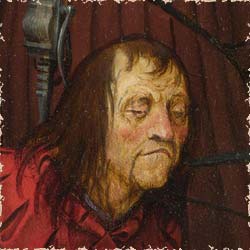
Asian King

European King

Asian King



Sources
- In Search of the Miraculous by Peter Deminaovich Ouspensky
- Turning the Heart to God by Theophan the Recluse (1815 – 1894)
- The Gospel According to John
- The Theory of Celestial Influence by Rodney Collin
- The Gospel According to Luke
- Philokalia, St. Hesychios the Priest
- The Gospel According to Matthew

In 2022/3, BePeriod will be creating a full-length documentary on George Gurdjieff
Subscribe to our mailing list
Subscribe to our mailing list
Continue Reading:
© BePeriod
